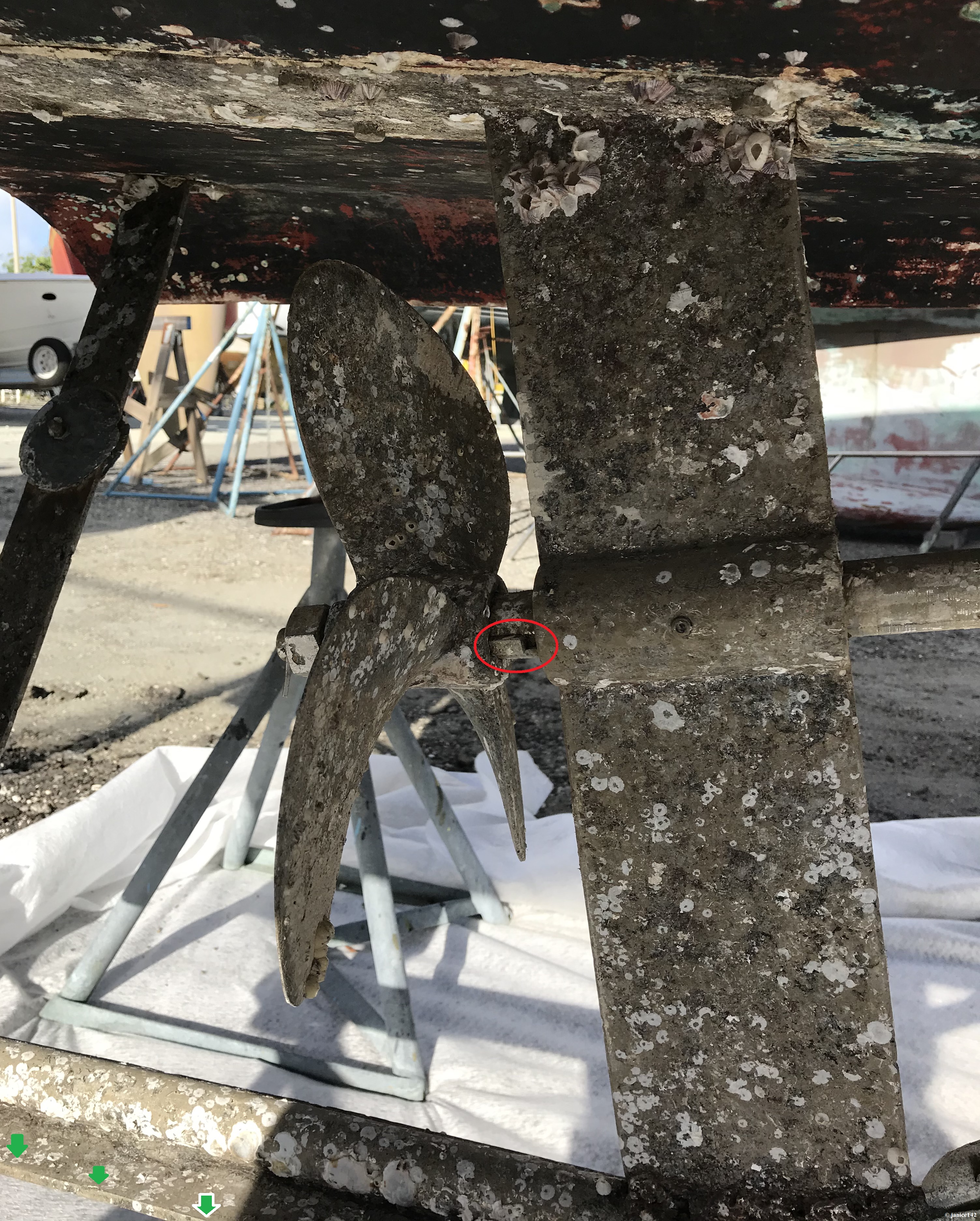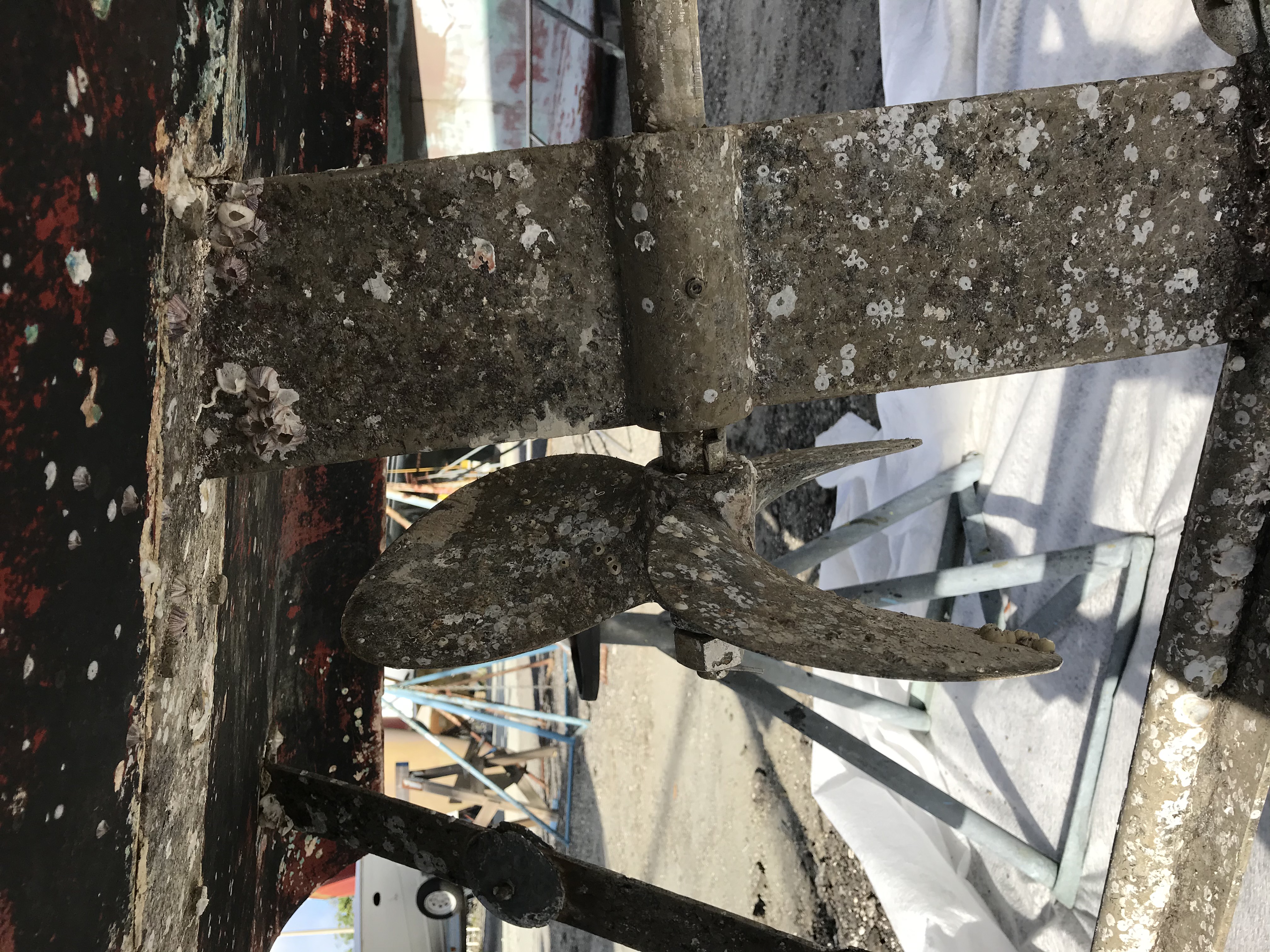![]() Home
|
The Boat |
First Mate
|
Admiral |
Guestbook
Home
|
The Boat |
First Mate
|
Admiral |
Guestbook
Date: 2 July 2020. How Shaft Keys Work.
© janice142
Aboard Seaweed I have had the "opportunity" to replace my shaft keys. The first time I did so for the one on my propeller, I used a galvanized replacement. That worked out just as well as you might expect. Abject failure was had. Experience has imparted to me the importance of having spare keys as a component of my parts inventory. Today I'll tell you what a shaft key is, where to purchase same, and why I believe you should have them aboard your vessel.
Shaft keys are made of square bar stock. That means the piece is square, and "bar stock" indicates that the item is solid versus hollow. Your shaft keys are made of bar stock and should be stainless steel. Galvanized steel will rust.
SQUARE BAR
STOCK ↓ made of 303 Stainless.

I bought my square bar stock aka keys from Midwest Steel and Aluminum (763-582-1925) company. Four years ago they were kind enough to cut mine to the lengths required. That was a great benefit to me. This is something you should purchase in advance. It is a low-cost item. Finding stainless steel is important.
You do not want to "make do" with something that will rust in salt water. TRUST ME on that. It will take a torch and a darn good welder to get the mess free for replacement. Thanks to Rocky for his skills in freeing the mess I created by Not doing things correctly when in a pinch.
To be perfectly fair, there was no local place to obtain stainless bar stock. Without the item Seaweed could not move so choices were made. I opted for galvanized, figuring "how bad can it be?"
Note to Self: When asking how bad can something can become, I should have realized things could get a lot worse than I initially imagined.
Shaft Lessons, the
whys and wherefores:
All shafts are robust solid metal.
Usually they are stainless steel though some high-dollar vessels opt
for monel.

I keep spare SHAFT ZINCS
↑ inside mounted on
the shaft. That way they won't get lost.
Almost all boats with inboard propulsion have a shaft. The shaft is a solid stainless steel or monel round bar. It spans between the transmission and the propeller. The shaft size is dependent upon the engine of the boat. More powerful engines generally have larger diameter shafts. At one end of the shaft is the transmission and coupler.
Here is a photograph of a
↓ COUPLER. The coupler is
between the transmission and the
↓ SHAFT.

Side Note: that is the yellow handle of a
THRU HULL SHUT OFF VALVE
and an 8-gauge BONDING WIRE.
Mini Lesson on Transmissions: The transmission has gears inside. When moving forward on a single engine boat like Seaweed, the gears turn clockwise. Reverse is the opposite. Now to connect all those gears to the shaft there is a coupler. It joins the shaft to the transmission.

The FLEXIBLE COUPLER is red. It is bolted between the
transmission and the regular coupler.
As I understand it, the purpose of a flexible coupler is to be sacrificial. If I do something stupid (hit something hard with my propeller) rather than destroy the inner workings of the transmission, the red coupler is designed to take the fall/break.
A mechanic back in Carrabelle
advised me to purchase
the flexible coupler. The cost was approximately $100.
The Coupler has a slot cut into it.
So does the shaft. The KEY
↓ (square bar stock) secures the two
together.

The flexible coupler is secured to the transmission. The "real" coupler is next in line. A slot is cut into the shaft and an equal one is in the coupler. The KEY fits into said slot. When combined, the key keeps the shaft in line. It turns with the internal gears of the transmission.

Lower half of picture: White transmission, red flexible
coupler, real coupler, shaft, and two zincs.
The zincs are NOT currently protecting the boat from electrolysis. Instead, they are there to help keep me from sinking!!! When underway were I to hit something hard enough to dislodge the shaft it could, theoretically, fall out. Those two zincs will prevent that from happening. It's a simple safety measure. The added bonus is that I always know where my spare zincs are located.
Seaweed is a single engine boat. My propeller is right-handed, meaning the prop turns in a clockwise direction when in forward gear. In other words, right goes forward. The gears inside the transmission turn. The coupler holds the shaft in place so it can rotate the propeller. Without a key at the transmission, the shaft will not spin.
What you need to know: First, you need to know both the size and length of bar stock your boat requires. It is my experience that both ends (transmission and propeller) are the same length. Yours may however differ.
Then, buy spares from the
Midwest Steel and Aluminum company. Phone: 763-582-1925

I was fortunate in that Midwest actually cut mine to the length required. If you don't know how much, simply order a one foot of the correct diameter so you will be prepared. This is one of those items that you don't need until you need it immediately.
|
Diagnosing a shaft key problem. Part One. |
|
|
Key for
transmission: When the aft end of your transmission rotates [
RED COUPLER
and THE GREEN AREA
→ ] and the
shaft does not, verify that your shaft key is okay.
|
|
|
|
|
Please know that Calder's Boatowners Mechanical and Electrical Manual 4the Edition is amazing. It provides exact directions on how to diagnose and fix almost everything on a diesel vessel. That said, I'm not an expert at the mechanical aspects nor do I have the physical strength to do what many men can. Therefore, I hire both muscles and expertise as required. |
|
|
Even though
I might not do the repair, knowing how |
|
Replacing shaft keys is not a normal maintenance
event. The key is generally replaced when you swap props.

NEW KEY INSTALLED
↑ just forward of the
propeller.
The first key I broke was at the propeller end of my shaft. This happened when Seaweed was more than 20 years old. I do believe this was the original key.
|
Diagnosing a shaft key problem. Part Two. |
||
|
Key for
Propeller: I started the engine. After
warming her up for a few minutes I put
Seaweed into forward gear. Nothing happened. There was zero
movement of boat. First I opened the bilge and verified that the
shaft was spinning. It was, yet there was no movement of water
at the transom.
Note: A line wrapped around the propeller would cause the shaft to not turn and/or vibrate horribly. |
||
|
When something breaks I always hope
the |
||
Locally (this was in Georgia) I could find no stainless shaft keys so opted for a galvanized one. How bad could it be? Let me tell you, that was an AWFUL decision. The galvanized piece rusted and rather than dissolving sealed itself to both the shaft and propeller. |
||
Rocky→ |
||
After installing the galvanized bar stock I went shopping online for a real shaft key. My searches lead me to Midwest Steel and Aluminum based in Minnesota. Because I knew the size and length required, they kindly cut my pieces to size. Not having to cut stainless steel was a Real Benefit to me. I now have spares. Shipping was prompt and the cost was reasonable.
|
In conclusion, I advise folks to purchase a foot or so of bar stock. |
|
How to find your size: Put your engine in neutral. Rotate your shaft. It should turn by hand. Look next to the transmission until you see the slot with a square piece of metal in it. That is your bar stock. Measure across that span. You now know your size.
|
|
Where to buy: Please note that I am not being paid for this! I needed stainless bar stock, could not find it locally, searched online, found a company, and ordered via telephone. They cut it to the length I specified and shipped it promptly. That's sounds like a good company, so I share their information here: Midwest Steel and Aluminum (763-582-1925) based in the United States. |

I keep my stash in a locker, just in case a shaft key is
required again. I am ready.
This isn't a fancy "big thing" however it is critical to the propulsion system of Seaweed. Without bar stock keys, my boat could not move through the water.
BAR STOCK KEY
↓
installed on shaft at the propeller:

This is life aboard Seaweed. I love my home. She is the best. Having a substantial spare parts inventory is important for my happiness quotient. Truly I am blessed.
Thank you for reading. I appreciate that.
I'd love to know if others have had shaft key issues.
Do you have spare bar stock aboard your boat?
|
Regarding the Comments Section, found at the end of every article:
|
COMMENTS:
© 2020, © 2023
Categories: Boat Talk, Books, Characters, Gear, In the Bilges, Locations, Money,
Preventing Injury, Step Edition
~
Previous Post ... ![]() ... Next Post
~
Birds bring Happiness
... Next Post
~
Birds bring Happiness
The Archive holds a running list with synopsis of published articles, and links to same.
A favorite aphorism: One of the advantages of being a captain, doctor, is being able to ask for advice without necessarily having to take it. Kirk on StarTrek TOS.
Every gift helps.
The Cruising Kitty is what boaters refer to as spending money. There's never enough aboard Seaweed!
I am also an Amazon Affiliate.



